I met Paul A. M. Dirac in 1962.

|
- When Paul A. M. Dirac visited the University of Maryland in October of 1962, I was a
first-year assistant professor, and I had to provide convenience for him. At that
time, I was confused. The Physical Review Letters was constantly sending out new
words, such as Regge poles, N/D method, bootstrap dynamics, strip approximation, etc.
However, to me, they did not sound like the physics I really wanted to do.
I was fortunate enough to spend 30 minutes alone with Dirac. I asked him what
I should do in physics. He said American physicists should spend more time to
understand Lorentz covariance. This was a totally unexpected answer to me.
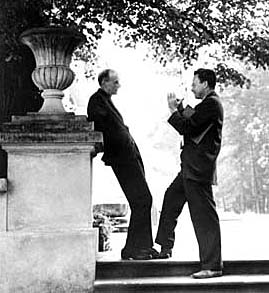
|
|
Dirac and Feynman in Poland while attending a relativity conference
hosted by Leopold Infeld in July of 1962.
I was there in 2013.
|
|
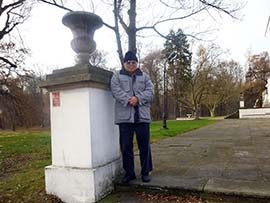
|
- It took me some time to understand what Dirac was really telling me.
First of all,
by American physicists, did he meet anyone in particular? It was not until after
reading some of Feynman's papers to realize he was talking about Feynman. Dirac was
right, Feynman or his students could have studied Lorentz transformations more
carefully. For instance, the paper with his students
contains many new physical ideas, but it is a total mess from the mathematical point
of view. They could have done much better job if they had studied Wigner's papers
on the Lorentz group.
Only after I read Feynman's papers, I realized Dirac was talking about Feynman when
he said "American physicists."
Dirac and Feynman met in July of 1962 (three months before I met Dirac). They met
in Poland.
- How about Dirac's papers? The best way to understand what Dirac told me in
1962 was to read Dirac's own papers. Dirac's papers all sound like poems, but they
do not contain figures. The best way to understand his papers is to translate
all those poems into cartoons. Here are thus my cartoons to tell you what Dirac
told me and what I did.
- First of all, let us translate what Dirac told me into a cartoon.
|
|
|
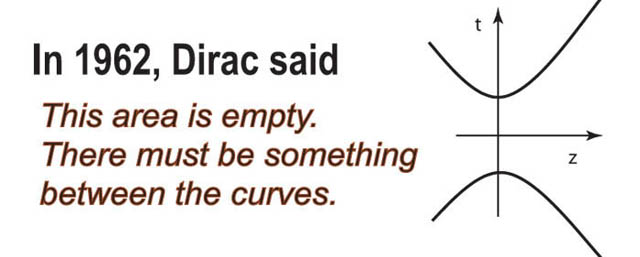
|
|
- It is quite safe assume that Dirac made many attempts to place something into
this empty space. Indeed, he did in the following papers.
- P. A. M. Dirac, Proc. Roy. Soc. (London) A114, 243 - 265 (1927).
- P. A. M. Dirac, Proc. Roy. Soc. (London) A183 , 284 -295 (1945).
- P. A. M. Dirac,
Rev. Mod. Phys. 21, 392 - 399 (1949).
- His papers are like poems. It is possible to translate those poems into the
following cartoons.
|
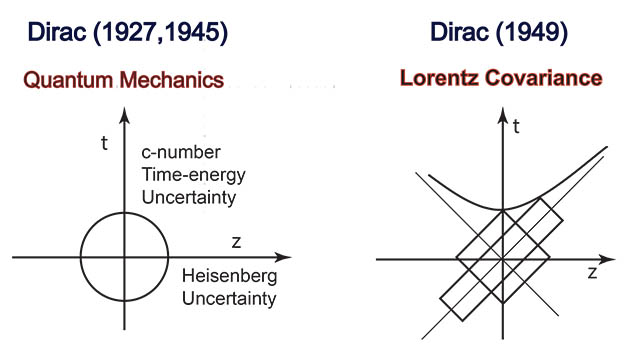
|
|
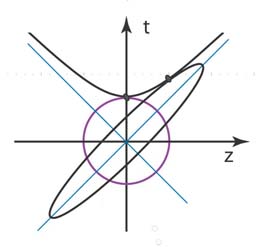
|
|
In the real world,
this ellipse appears as
|
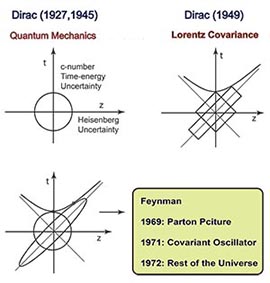
|
- You do not have to be a genius to combine the above two figures. This figure
means many different things in physics. Among them are
- Lornerz-covariant picture of bound states.
- Quarks and partons as one Lorentz-covariant entity.
- Coupled Oscillators as a model for the Lorentz-covariant world.
- Squeezed states of light.
- Squeeze transformations in physics. Symplectic transformations.
- Feynman's rest of the universe.
- Role of entropy in the Lorentz-covariant world.
- Entangled space and time variables.
|
|
- copyright@2012 by Y. S. Kim, unless otherwise specified.
- Click here for Y. S. Kim's home page.
- His Einstein page.
- His Princeton page.
- His Style page.
- The photo of Dirac and Feynman is from the Caltech Photo Archive.
This photo was taken by Marek Holzman during the International
Conference on Relativity Theory of Gravitation in Warsaw (Poland)
on July 25-31 1962, organized by Leopold Infeld. The image of Jesus
and Nicodemus is from "The Picture Bible" (David C. Cook Publishing Co.,
Elgin, Illinois, U.S.A., 1978).
|
|